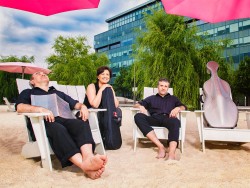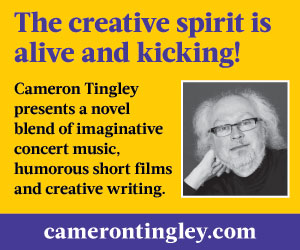 Summer’s turning out to be another scorcher, beckoning with promises of endless sun-kissed days filled with music festivals. There’s always an embarrassment of riches on display, but the ones brimming most with energy and enthusiasm, abuzz with imagination and excitement— the most toe-tapping and hum-inducing — seem to be the open-air concerts.
Summer’s turning out to be another scorcher, beckoning with promises of endless sun-kissed days filled with music festivals. There’s always an embarrassment of riches on display, but the ones brimming most with energy and enthusiasm, abuzz with imagination and excitement— the most toe-tapping and hum-inducing — seem to be the open-air concerts.
Everyone loves them: families with boisterous young children, courting couples, friends exploring new music, aficionados revisiting old favourites, thrill-seeking tourists seeking out novel experiences. And then there are the homing pigeons, the ones who return season after season, the ones who think they know all the best-kept open secrets, and very often want to share them!
This column is being launched in that spirit of sharing, of shining the spotlight on the obvious, and the not-so-very obvious: on the role that programming plays in the myriad musical discoveries that everyone shares, and the personalities that shape the journeys we all take. These are the people who work tirelessly behind the scenes to create a very public experience. They might even be people with very public personae or, equally, very private ones. What they all share, unequivocally, is a sense of passion, an infectious enthusiasm and the ability to get things done.
This issue, we focus on the artistic directors of three festivals that bask in the sun. Why? Because, as Tamara Bernstein attests, “Artistic Directors, like chefs, have to be adventuresome and curious, and at the same time express their own style and passions.” Nor, despite helming festivals that are very different in nature, are they narrowly confined to specific genres. There’s a lot of crossover in their often eclectic programming. The effect is often a dizzying mix of the electric and the electrifying, the familiar and the oddly reminiscent.
The ubiquitous Beaches International Jazz Festival is obviously the grande dame as it nears its 25th anniversary and continues to attract close to a million party-goers. It commandeers six stages at the Kew Gardens, the Boardwalk and Woodbine Park to feature genre-blending and –bending sounds, everything from Big Band, funk and soul, to Latin rhythms, Calypso and World Beat. This year, there’s even home-grown, certified Canadian organic Balkan Klezmer Gypsy Party Punk, courtesy of Lemon Bucket Orkestra. Artistic director Bill King explains: “The audience doesn’t go to see jazz. They want to be entertained, they like to be surprised. If you give them something memorable, they keep coming back.”
“The first priority is to make the experience memorable because it uniquely revitalizes the whole person,” agrees Roman Borys, artistic director of the Ottawa Chamberfest, the world’s largest chamber music festival, which has also booked the self-same Lemon Bucket for its closing bash.
Begun in 1994, the Chamberfest showcases about 250 local and international musicians playing 100 intimate concerts in three churches and the mausoleum of a cemetery, as well as the National Art Gallery and the National Arts Centre. While all this sounds impossibly stately, as befitting the national capital, it’s the Waterway Soundfaire that has attracted as many pedestrians as cyclists, local families as well as tourists. What started as the Musical Breeze Bicycle Parade in 2008, wends its way from Lansdowne Stadium on the west bank of the Rideau Canal to sample a delectable array of musical interludes before ending up under the bridge. It may seem like a splash of whimsy amidst the heavy hitters of the ensemble world but, as Borys explains, “There has to be a multi-layered approach to audience development.”
He is keenly aware of the growing reputation of the festival not just for tourists across the country but from further afield. He’s very much hands-on as he grapples with formidable software to schedule performances, track audiences, ask for donations, manage ticketing, conduct marketing campaigns — in short, to get the Chamberfest message across.
“Technology is a major step in the evolution of an organization as it’s used to capture and share information,” he says. He’s proud that, for the first time this year, audiences will be able to navigate through and attend every single performance, if they so choose, with meal stops and a bus shuttle to boot. That was a particular flourish inspired by the Finnish Kuhmo Chamber Music Festival founder and fellow cellist Seppo Kimanen.
The Music Garden was actually the title of the first film in a six-part series that inspired cellist Yo-Yo Ma to work with landscape designer Julie Moir Messervy to interpret Bach’s Suite No.1 for Unaccompanied Cello as an actual garden. Although the Music Garden comprises six sections, each corresponding to a different dance movement of Bach’s suite, it’s the last movement, the Gigue, transformed into giant grass steps, that provides the lakeview arena where the performances take place.
The Music Garden is a relative teenager on the open-air music circuit, having been officially opened only in 1997, but it already draws a devoted crowd. Bernstein, who curates the roster of concerts for Harbourfront Centre, remembers the first year when “audiences — sometimes families with kids — patiently waited out thunderstorms until artists could perform with all their hearts once the sun came out again … One time the string players of the Gryphon Trio performed in the truck with which we had transported the sound equipment, because it was too damp for their instruments outside, and the audience was so hungry to hear them. It was so exciting and crazy!”
What’s changed in the last baker’s dozen years? “Performers don’t get wet any more! We are more careful about rain calls! And we have shade umbrellas for the performers, which protect valuable instruments,” she’s quick to respond. “Oh! One not so good change is the noticeable increase in dogs who poop in the Music Garden, and whose owners don’t clean up after them. “
For King, what’s changed in the last two and a half decades is technology. Where he used to have to wade through a mountain of paperwork, King says, “I don’t need histories or band photos any more.“ Youtube videos now tell him everything he needs to know about how bands play, how they communicate with their audience and if they have any stage presence at all!
It probably comes as no surprise to anyone that King, Borys and Bernstein are musicians themselves. King is a jazz pianist in his own right, Bernstein trained as one herself and founded the Community Baroque Orchestra of Toronto, while cellist Borys is one-third of the Gryphon Trio, with violinist Annalee Patipatanakoon and pianist Jamie Parker, who both also serve as advisors. They’ve all been where young musicians are, striving to perfect their craft, looking for support, seeking their first appreciative audiences. So if there’s one belief that they all share, it’s the role they play in providing a platform for Canadian performers to shine — and then some!
“Right from the start, we were presenting Canadian artists on the main stage. That’s why, if there’s something good, I’ll find a spot for them,“ says King. “So we focus on the best Canadian artists each year, and it’s pretty much been the same every year.”
Borys is particularly excited about seeing so many young musicians actively seeking and committing to careers in chamber music. “Full-time ensembles need festivals and organizations to support them from year to year,” he notes.
As teachers, he, Patipatanakoon and Parker are an integral part of a community that sources as well as provides referrals to an entire corps of students, or friends and acquaintances of former students who find their way to them.
“What’s chamber music but great ensemble playing?” he says about creating opportunities for younger players, and string quartets in particular.
Although Borys is proud of the international roster of performers who play with the Canadian performers, he’s even more adamant about providing a platform for Ottawa musicians.
Like King and Borys, Bernstein’s view reflects her own openness to diverse experiences and her connection to her roots: “At the same time, I learn about new genres, and discover new performers and composers each year, I strongly feel that the series needs to reflect the multiculturalism of the city, within the mandate of classical, traditional and new music.”
What’s more, taking a bird’s eye view of programming has taken on a perspective none would ever have assumed if each had remained a mere performer.
Little did he know when he first took that fateful phone call and biked along the Martin Goodman Trail, looking for a suitable site. “After nearly 25 years,” muses King, “it’s become a part of my history. I never thought about it, but I’m very proud of how thousands of musicians have been given the opportunity to launch or further their careers.” He pauses to consider the likes of Michael Kaeshammer, Tyler Yarema and Carol Welsman, and then points out that the Beaches Jazz Festival is still voted the number one summer event — “because it’s done in such a classy way, people come out and have an amazing time. “
Borys smiles when he admits that practising musicians are notorious for not attending performances. But now that he’s making key decisions about performances, he’s actually attending as many performances as he can and meeting the audiences. “I’m actually enjoying the musical experience, having the critical ear and sharing the collective consciousness. I really feel the shock of the music stopping at the end of a performance!”
As for Bernstein, “I now know for sure that this kind of performance event — free, universally accessible concerts given by fantastic artists — gives a city its soul. I also know for sure now that there is no classical music (from any culture) that the so-called general public won’t “get,” or won’t love. We’ve been packing in the crowds to hear string quartets, musique actuelle, crazy 17th century baroque music. It’s all about the performers’ passion, and their ability to connect with audiences — and their skill, of course!”
And this happens because it’s all about the programmers’ passion, and their ability to connect with audiences — and their skills, of course.
Rebecca Chua is a Toronto-based journalist who writes on culture and the arts.



